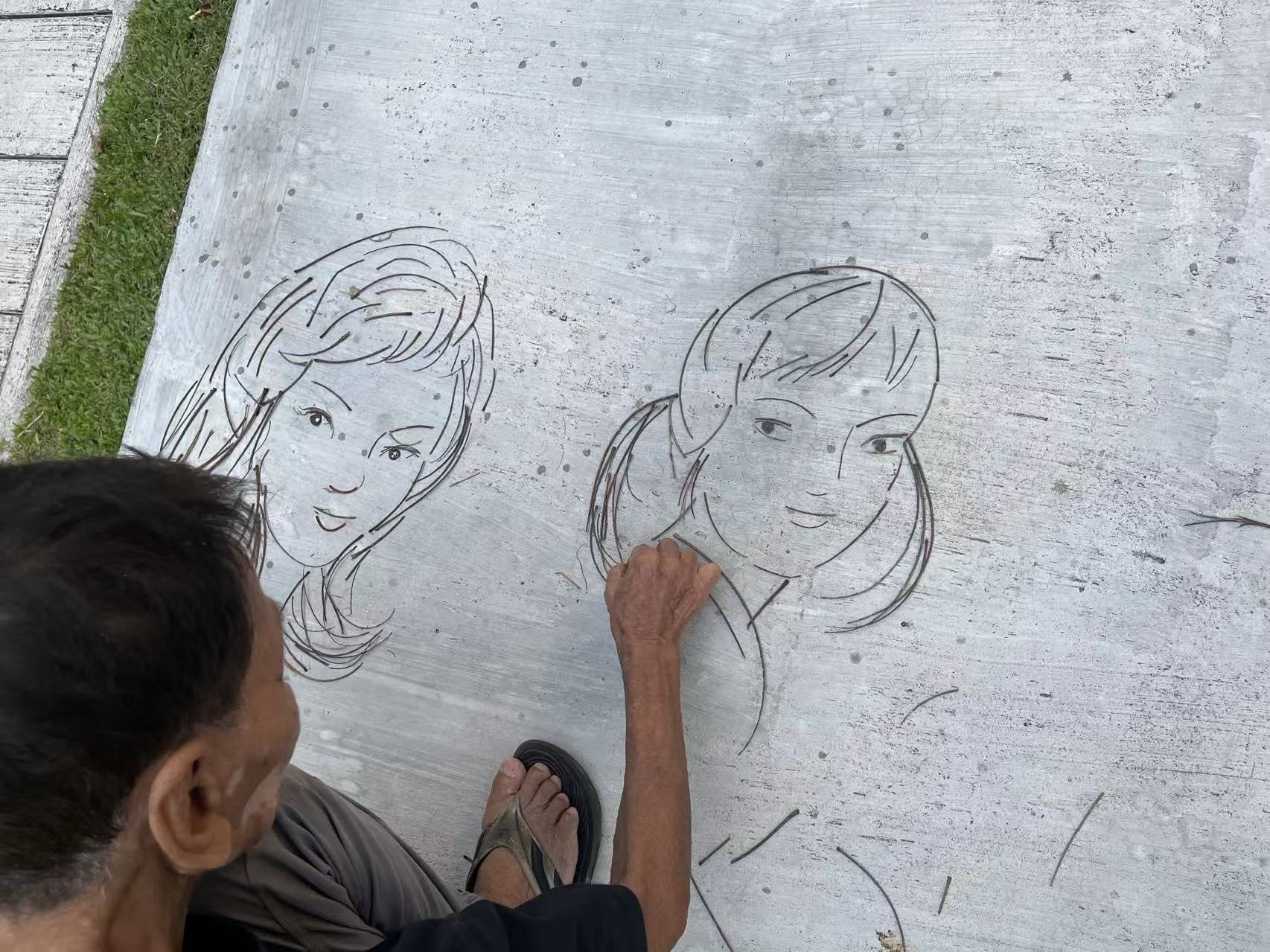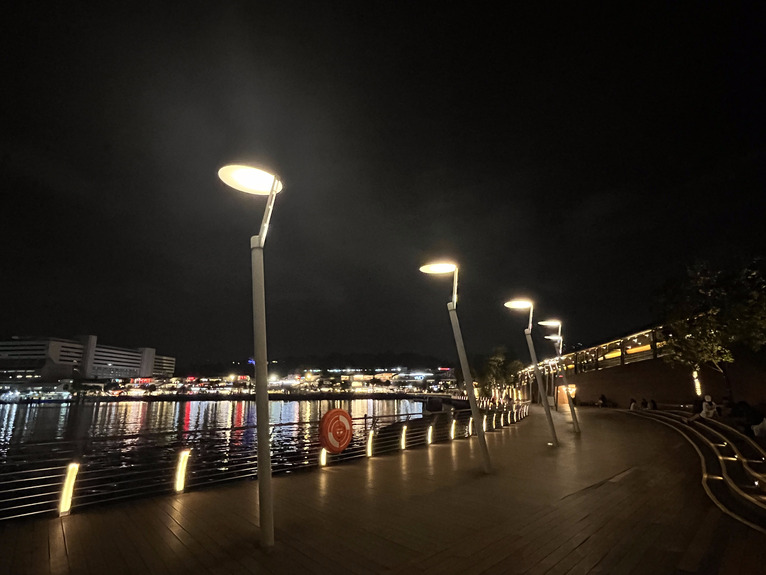Neon
“We’ll never stop this train.” — John Mayer
Lessons from Fishing
- Success is a mindset
The way you feel depends a lot on what you perceive as success.
If you set the goal as being able to achieve some kind of probabilistic thing like catching a fish, you will either leave satisfied or dejected. Don’t base your success off of a random event.
Instead, try to think about improvement and practice. If you make your goal to improve the accuracy and timings of your casts and retrieves, that will bring much more satisfaction because you will never be in that state of sadness after failing to reach your arbitrary goal.
- Every system fails at the weakest link
When I was learning to tie fishing knots (still am), I got snagged on the pier. It wasn’t the rod that broke, not the string, but the knot that untangles.
Flashing… Lights? Lights?
Bathroom at office had autoflush and in the beginning I kept getting splashed randomly because the lights would always turn blue and red and I had no idea what it meant. Eventually, I figured out the ordering:
- Dark: Has not detected object
- Blue: Has detected object
- Red: Secure, if distance increases, go next stage
- Flashing red: Armed, if you are too far for too long, fshh…
Liminal
While watching the Solar Sands video below, I knew that the picture was generated by a GAN (generative adversarial networks) or something but…
He mentioned the series of albums starting with the below, which describes each stage of dementia.
I didn’t listen to the whole thing because I was listening to it at work and it was making my mind completely fuzzy, which I guess is the intended effect, but I do recommend giving each stage a sample.
It’s just a burning memory
I wonder what it would be like to not be able to remember anything; it’s scary but more in an inescapable way like claustrophobia as opposed to creepy-looking things like spiders or something.
One of the scariest stands in JoJo only allows the affected to remember 3 things at once. If you learn a fourth thing, the first thing gets deleted from your mind.
Food Hawk
I was complaining to a Singaporean friend of a friend about the terrible food in Singapore and then they said to stop trying restaurants and to just eat at hawker stalls.
The idea slipped my mind because I thought I basically tried every kind of hawker stall until I realized that just going to the same two for lunch every day does not count as having seen every single hawker stall.
There truly is a wealth of food culture in Singapore. Even though some have become commercialized trash, many of the stalls have properly distilled Southeast Asia’s spirit and culture.
Friend Kway Teow
When I sat down at a Chinatown Complex table at 2 PM with my fried kway teow, I noticed that the Indian dude diagonal to me was also eating from the same stall, so we got along quite well.
Tip: if you meet someone who wakes up at the same time as you just to go eat food, you are probably going to be friends.
I asked him where he thought the best food was and he recommended me to go to Outram Fried Kway Teow and Maxwell’s Tian Tian Chicken Rice.
However, I told him what I’m gonna tell you right now, which is that Tian Tian is incredibly overrated and you might as well just go to the chicken rice directly next to it because it’s a shorter line for basically the same thing.
Oliver’s Cheesecake
Then, he told me that there was a good cheesecake at place called quiec by Olivia, which was INCREIDBLE.
The cheese oozes out of the center and is deeply flavorful since it uses some blue cheese and is torched on top.
It’s like the Frank Pepe of cheesecake though, because the first few bites is delicious, and the final stretch is incredibly difficult.
It’s just a burning memory
After having not been at Caltech for so long, I’ve actually begun to miss Red Door. Perhaps I miss the food?
I’m not that senile (yet), but right now, I could really go for a corndog and, dare I say, a matcha latte.
Belief
From going to places where people eat and how they eat, you can tell what they believe in.
People in Singapore love queuing for food, probably based on the assumption that the more people are queueing, the better the food is. However, that isn’t necessarily the case.
It could just be that the one with a line is preparing the food slower than the other stalls.
Crazy Train
After riding the subway so many times and listening to “Smooth Criminal” so many times (separately), I began to wonder how much you degrees could lean without falling over or slipping on the subway.
After thinking for some time, the two key variables to solve for are acceleration of the train and the friction coefficient between you and the floor.
- If there’s not enough friction, you’ll slide sideways.
- If the train is not accelerating enough, you won’t be able to lean as much.
For acceleration, I’m not too sure, but it takes $2$ minutes to go $1200$ meters. So, if you view the speed vs time graph, you get a kind of trapezoid where you increase to top speed, then flat, then drop down.
So, the area of this trapezoid is $1200$ meters, and let’s call the acceleration time $S$, in which case the area of this trapezoid can be represented as $(120-S)$ times the max speed.
The max speed is actually acceleration times $S$ under constant acceleration, so if you just plug in $10$ seconds for $S$, you get that the $a = 1.1 ms^{-2}$.
Stop This Train
So, friction has to provide all of this acceleration for your body, but incorporating friction actually makes the problem way harder when using center of mass as reference point because then you have to solve position and angular equations.
Now, we do need to consider normal force if we want to know what happens with slipping, but I remember from high school physics that the coefficient of friction between wood and wood is $\mu = 0.3$, which means my feet are definitely not coming off the ground.
Let’s instead use the foot on the car as the point of reference, theta being angle with the ground. Say that your center of mass is $1$ meter above ground.
Then you have a torque from gravity $(g\cos(\theta))$ and opposite one from train acceleration, $(a \sin(\theta))$, on this point.
To solve for $\theta$, $g/a = \tan(\theta)$, so $\theta = \arctan(9)$ which is approximately $83 \degree$.
That’s quite a small lean, so it seems like we “are OK.”
Transformers
I’ve been self-studying transformers recently, which really built on my limited understanding from courses, but I’d like to attempt the Feynman technique of learning through teaching, so here is how a transformer works:
Data Format
I’ve noticed that understanding the type of data that goes into and comes out of the model really influences my understanding of how the interior mechanisms work, because I believe the inside is designed based on the outside, just like Alan Turing’s code breaker.
Transformers deal in sequence(s) of values, the values could be pixels, words, or locations. Whatever you want, as long as it’s a sequence. You give it some sequences and it learns how to predict future values based on all or some of the past values.
Example: I give the transformer a list of the paths I jog on, and the paths are sequences of locations at various times in the jog. Then, I give today’s starting point and it will guess the rest of the path.
Internal Workings
The transformer is made of attention blocks, which have a few variants, but the basic one is the attention layer which is a bunch of matrices, which goes to a 2-layer neural network, and this repeats a bunch of times.
Attention blocks take the input and project it into 3 matrices by separately multiplying by the query, key, and value matrices to get Q, K, and V. Once you get all three, you do Q times K times V to get the attention matrix.
But what do Q, K, and V mean?
- Well say you have a word like “cat,” which has been turned into a vector. This vector becomes a vector in Q, K, and V, where Q asks what other words should matter to cat, K is the value of cat to other words, and V is the actual meaning of cat.
What’s the point of the neural network?
- Add nonlinearity to the model
Neon, Neon
I’ve been a bit obsessed with John Mayer’s “Neon” so I’ve decided to buy a guitar in my last month in SG. My goal is to be able to play the live version at least without including the crazy solo part in the middle.
Note: By October, I am now OK at playing it. Feels like there is about 50% more to go.
E
I met up with my friend E, who used to be one of my profs, we caught up and talked a lot about research, AI, PhDs, the usual topics.
My current conflict over applying to PhD or going straight to a job is the state of funding in academia.
By the time I graduate in 2027, the funding situation will probably be the same. Perhaps this will lead to less applicants, but the job market is also bad, so more people may choose to delay their entry to the job market.
There also aren’t any clear stats on PhD applications per year, but Google Trends shows that the interest in “how to get into a phd program” has risen greatly, but “how to get a trade” has also risen, and has more interest.
I’m not sure what this means, perhaps a rejection of higher education or a rejection of office jobs.
EW
I picked up my friends E and W from the airport and we had some kaya toast. It was kind of like seeing cartoon characters in real life.
E was watching JoJo on the plane and I totally forgot that they went to Singapore on the way to Egypt. After spending some time on Google Maps, I was able to find some of the locations that appeared:
- Victoria Concert Hall: This is in a lot of the backgrounds
- Sultan Mosque: It’s not exactly the same building, but there’s a scene where it appears next to some train tracks.
- Shangri-la Singapore: Hotel that they stay at, seems close to the Takashimaya, which ChatGPT says is where lots of Japanese people stay in Singapore.
- Harborfront cable cars: I had no idea that the popular meme where Kakyoin goes “rerorerorero” happened in Singapore!
Demon Slayer
The new movie is pretty epic, but I realized that was just because I forgot the plot completely and that there’s just some emotional and animation value.
Master Cheng
One day on Instagram reels, I saw mention of an elderly twig artist by the name of Uncle Thien who hangs out on Owen Rd and makes portraits of people, which I found to be incredibly skillful.
So, I looked up Owen Rd, and it was two streets away from where I lived, Rangoon Rd. So, I decided to go on a walk one day after work to find him. I couldn’t find him along the road on the first day so I went home and tried again the next day.
I tried to reference the pictures of him online and noticed that there were two adjacent small yellow and black pillars which can only be found next to HDB carparks. So, I looked through every HDB carpark and found him next to a food center doing his thing.
Introductions
I introduced myself as a student from America and Shanghai who does art as a hobby and he asked for my “honored surname” which I said was Zhang, “as in octopus,” and he formed it with twigs on the floor and then I asked for his name and he said that his surname was Cheng, which was different from Thien from online.
I haven’t heard that surname before so he took the twigs from Zhang and formed the character Cheng on the pavement as well, which I understood.
I asked if I could do an interview for my school newspaper with him, and he politely refused, stating with a four-word proverb: “Fame brings disaster.” Which I found incredibly insightful; which is why I’m now writing it on my blog.
Basic Questions
Q: When did you start learning art?
A: I never really formally learned it, just self-studied.
Q: When did you start doing twig art?
A: Last year.
Q: How long did that drawing take?
A: Probably like an hour.
Q: When do you usually show up?
A: Probably like 5 or 6
Q: What are the eyes made of?
A: The right is a bit of cloth I cut up, the left is a rock I found.
Q: We’ve been squatting for a while (stands up), my legs are already (ma2) asleep, you must be very strong.
A: Yeah, if you don’t practice squatting it’s gonna be quite difficult to squat for this long.
Q: How do you usually start a portrait? Eyes? Hair?
A: You can start wherever you want, just make sure it’s a part that you are familiar with.
So long
He said he started doing twig art last year, but I found videos about him from 2020.
Three days after I met him, I again asked him when he started, and he said two years ago, so I think his memory may be somewhat fuzzy.
I also learned a lot more from him in later lessons, but I suppose that can wait for a later day since this post is way too long.
One thing I will say is that it’s important to appreciate the people around you.






Leave a comment